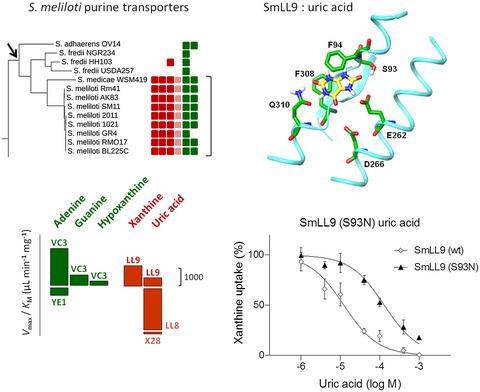当前位置:
X-MOL 学术
›
Mol. Microbiol.
›
论文详情
Our official English website, www.x-mol.net, welcomes your
feedback! (Note: you will need to create a separate account there.)
Specificity profile of NAT/NCS2 purine transporters in Sinorhizobium (Ensifer) meliloti.
Molecular Microbiology ( IF 2.6 ) Pub Date : 2020-03-21 , DOI: 10.1111/mmi.14503 Maria Botou 1 , Vassilis Yalelis 1 , Panayiota Lazou 1 , Iliana Zantza 2 , Konstantinos Papakostas 1 , Vassiliki Charalambous 1 , Emmanuel Mikros 2 , Emmanouil Flemetakis 3 , Stathis Frillingos 1
Molecular Microbiology ( IF 2.6 ) Pub Date : 2020-03-21 , DOI: 10.1111/mmi.14503 Maria Botou 1 , Vassilis Yalelis 1 , Panayiota Lazou 1 , Iliana Zantza 2 , Konstantinos Papakostas 1 , Vassiliki Charalambous 1 , Emmanuel Mikros 2 , Emmanouil Flemetakis 3 , Stathis Frillingos 1
Affiliation

|
Sinorhizobium (Ensifer ) meliloti is a model example of a soil alpha‐proteobacterium which induces the formation of nitrogen‐fixing symbiotic nodules on the legume roots. In contrast to all other rhizobacterial species, S. meliloti contains multiple homologs of nucleobase transporter genes that belong to NAT/NCS2 family (Nucleobase‐Ascorbate Transporter/Nucleobase‐Cation Symporter‐2). We analyzed functionally all (six) relevant homologs of S. meliloti 1,021 using Escherichia coli K‐12 as a host and found that five of them are high‐affinity transporters for xanthine (SmLL9), uric acid (SmLL8, SmLL9, SmX28), adenine (SmVC3, SmYE1), guanine (SmVC3), or hypoxanthine (SmVC3). Detailed analysis of substrate profiles showed that two of these transporters display enlarged specificity (SmLL9, SmVC3). SmLL9 is closely related in sequence with the xanthine‐specific XanQ of E. coli . We subjected SmLL9 to rationally designed site‐directed mutagenesis and found that the role of key binding‐site residues of XanQ is conserved in SmLL9, whereas a single amino‐acid change (S93N) converts the xanthine/uric‐acid transporter SmLL9 to a xanthine‐preferring variant, due to disruption of an essential hydrogen bond with the C8 oxygen of uric acid. The results highlight the presence of several different purine nucleobase transporters in S. meliloti and imply that the purine transport might be important in the nodule symbiosis involving S. meliloti .
中文翻译:

蜜蜂中华根瘤菌中NAT / NCS2嘌呤转运蛋白的特异性谱。
苜蓿中华根瘤菌(Sinorhizobium(Ensifer)meliloti)是土壤α-变形杆菌的典范实例,它诱导了豆类根系上固氮共生根瘤的形成。与所有其他根瘤菌菌种相比,苜蓿链球菌含有属于NAT / NCS2家族的核碱基转运蛋白基因的多个同源物(Nucleobase-抗坏血酸转运蛋白/ Nucleobase-Cation Symporter-2)。我们使用大肠杆菌在功能上分析了苜蓿链球菌1,021的所有(六个)相关同源物K-12作为宿主,发现其中五个是黄嘌呤(SmLL9),尿酸(SmLL8,SmLL9,SmX28),腺嘌呤(SmVC3,SmYE1),鸟嘌呤(SmVC3)或次黄嘌呤(SmVC3)的高亲和力转运蛋白。底物谱的详细分析表明,这些转运蛋白中的两个显示出更大的特异性(SmLL9,SmVC3)。SmLL9在序列上与大肠杆菌的黄嘌呤特异性XanQ密切相关。我们对SmLL9进行了合理设计的定点诱变,发现XanQ的关键结合位点残基在SmLL9中是保守的,而单个氨基酸变化(S93N)将黄嘌呤/尿酸转运蛋白SmLL9转化为黄嘌呤。 -首选变体,因为必需的氢键与尿酸的C8氧原子被破坏。结果突出了在S. meliloti中存在几种不同的嘌呤核苷碱基转运体,暗示嘌呤转运在涉及S. meliloti的结节共生中可能是重要的。
更新日期:2020-03-21
中文翻译:

蜜蜂中华根瘤菌中NAT / NCS2嘌呤转运蛋白的特异性谱。
苜蓿中华根瘤菌(Sinorhizobium(Ensifer)meliloti)是土壤α-变形杆菌的典范实例,它诱导了豆类根系上固氮共生根瘤的形成。与所有其他根瘤菌菌种相比,苜蓿链球菌含有属于NAT / NCS2家族的核碱基转运蛋白基因的多个同源物(Nucleobase-抗坏血酸转运蛋白/ Nucleobase-Cation Symporter-2)。我们使用大肠杆菌在功能上分析了苜蓿链球菌1,021的所有(六个)相关同源物K-12作为宿主,发现其中五个是黄嘌呤(SmLL9),尿酸(SmLL8,SmLL9,SmX28),腺嘌呤(SmVC3,SmYE1),鸟嘌呤(SmVC3)或次黄嘌呤(SmVC3)的高亲和力转运蛋白。底物谱的详细分析表明,这些转运蛋白中的两个显示出更大的特异性(SmLL9,SmVC3)。SmLL9在序列上与大肠杆菌的黄嘌呤特异性XanQ密切相关。我们对SmLL9进行了合理设计的定点诱变,发现XanQ的关键结合位点残基在SmLL9中是保守的,而单个氨基酸变化(S93N)将黄嘌呤/尿酸转运蛋白SmLL9转化为黄嘌呤。 -首选变体,因为必需的氢键与尿酸的C8氧原子被破坏。结果突出了在S. meliloti中存在几种不同的嘌呤核苷碱基转运体,暗示嘌呤转运在涉及S. meliloti的结节共生中可能是重要的。











































 京公网安备 11010802027423号
京公网安备 11010802027423号